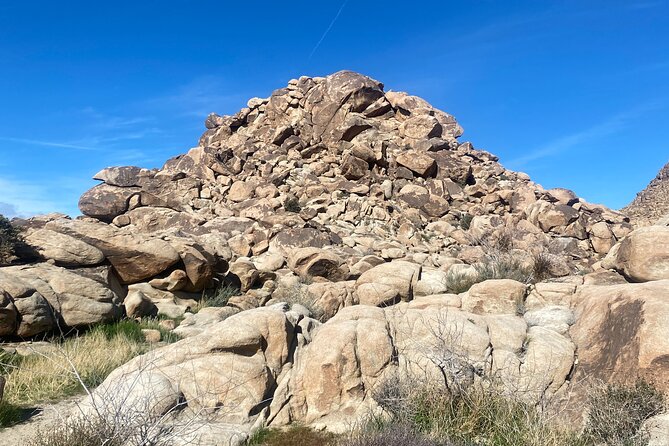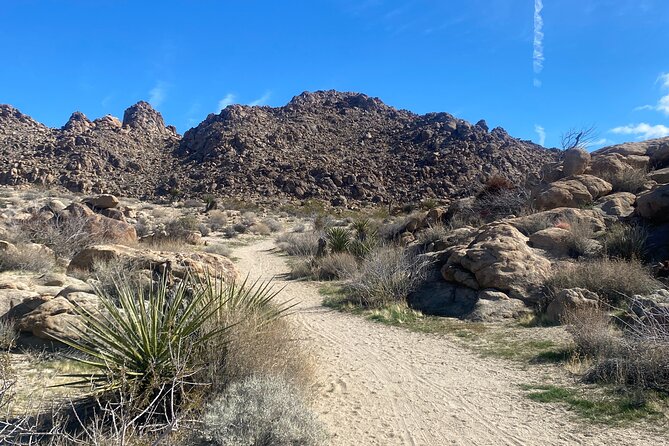The Natural Wonders Walk in Joshua Tree National Park offers an immersive experience into the park’s captivating desert ecosystem. Participants explore the diverse flora, including iconic Joshua trees and vibrant wildflowers, while learning about the unique adaptations of desert wildlife. The walk also delves into the geological marvels of towering rock formations, providing insight into the Earth’s history. Discover how this delicate environment relies on the intricate relationships between plants, animals, and rocks to thrive.
Good To Know

- The Natural Wonders Walk in Joshua Tree National Park offers an educational exploration of the diverse flora, fauna, and geological formations that characterize the desert landscape.
- Participants can learn about the remarkable adaptations of desert plants, such as waxy coatings and deep taproots, which enable them to thrive in the arid climate.
- The walk provides opportunities to spot and learn about the park’s diverse wildlife, including bighorn sheep, kangaroo rats, and colorful birds like the Phainopepla.
- Towering rock formations, shaped by wind and weather over millions of years, offer insights into the geological history and complexity of the Joshua Tree region.
- The Natural Wonders Walk emphasizes the delicate balance of the desert ecosystem, highlighting the importance of preserving the fragile resources that sustain the park’s plants and animals.
The Enchanting Joshua Tree Landscape

Although Joshua Tree National Park is known for its rugged desert landscape, the natural wonders that await visitors are truly enchanting.
The park’s iconic Joshua trees, with their twisted, sculptural forms, dot the sandy terrain, creating a surreal and otherworldly atmosphere. Vibrant wildflowers bloom in the spring, painting the desert floor with splashes of color.
Towering rock formations, carved by wind and time, stand as silent sentinels, inviting exploration. From the prickly pear cacti to the scurrying lizards, the diverse flora and fauna of Joshua Tree captivate the senses and ignite the imagination.
You can also read our reviews of more walking tours in Palm Springs
Exploring the Diverse Flora of the Desert

As visitors explore the diverse flora of Joshua Tree, they’ll discover a remarkable array of desert-adapted plants that thrive in the arid climate.
From the iconic Joshua trees with their spiky leaves to the hardy creosote bushes, the landscape bursts with life.
Visitors can spot the vibrant blooms of the desert lavender, the intricate patterns of the teddy bear cholla, and the striking silhouettes of the barrel cacti.
Each plant has developed unique survival strategies, such as waxy coatings and deep taproots, to conserve water and withstand the harsh desert conditions.
Exploring this botanical diversity is a highlight of any visit to Joshua Tree.
Discovering the Fascinating Fauna of Joshua Tree
Visitors to Joshua Tree National Park are captivated by the diverse array of fascinating fauna that call this desert habitat home.
Iconic wildlife like bighorn sheep, kangaroo rats, and Gila monsters roam the rugged terrain. Colorful birds like the striking Phainopepla and the Roadrunner dart among the Joshua trees.
Reptiles like the chuckwalla lizard and the desert tortoise bask in the sun. Nocturnal creatures like the kit fox and the coyote emerge at dusk.
This private guided hike offers the chance to spot and learn about the park’s amazing animals in their natural environment.
Uncovering the Geological Wonders of the Region
The captivating geological features of Joshua Tree National Park have long enchanted visitors.
Towering rock formations, sculpted by wind and weather, dot the landscape. Hikers can explore ancient volcanic intrusions, granite outcroppings, and distinctive desert soils.
A highlight is the unique Joshua trees, whose twisted branches and spiky leaves are the product of the region’s geology. Participants on the Natural Wonders Walk will learn about the park’s complex rock formations and the forces that shaped them over millions of years.
From rugged mountains to alluvial fans, the park’s geology offers a window into the Earth’s history.
The Vital Role of Native Plants in the Ecosystem
Though often overshadowed by Joshua Tree’s dramatic geology, the park’s native plants play a vital role in the delicate desert ecosystem.
These hardy and resilient plants have adapted to the extreme climate, conserving precious water and providing food and shelter for a diversity of wildlife.
From the iconic Joshua tree to the vibrant wildflowers, each species contributes to the intricate web of life.
Protecting and maintaining this botanical heritage is crucial for the park’s ecological balance and the enjoyment of visitors seeking to enjoy the natural wonders of this unique landscape.
- Palm Springs: City and Desert App-Guided Driving Tour
- Palm Springs: Indian Canyons Hiking Tour by Jeep
- Palm Springs: Self-Guided Scavenger Hunt Walking Tour
- San Andreas Fault Jeep Tour From Palm Desert
- Palm Springs & Joshua Tree: National Park Self-Guided Tours
- Palm Springs: City Highlights Scavenger Hunt Smartphone Game
Observing the Adaptive Behaviors of Desert Animals
Alongside the captivating plants, Joshua Tree’s desert inhabitants have ingeniously adapted to the harsh environment.
Bighorn sheep, for instance, possess wide hooves that prevent them from sinking into the loose sand.
Kangaroo rats, adept at water conservation, can go their entire lives without drinking.
Coyotes, with their exceptional hearing and eyesight, efficiently hunt prey.
Roadrunners, with their distinctive long legs, can outrun predators.
Rattlesnakes, with their ability to sense vibrations, detect approaching threats.
These remarkable adaptations enable the desert creatures to thrive in the rugged terrain and scarce resources of Joshua Tree National Park.
Understanding the Unique Rock Formations of Joshua Tree
Towering granite monoliths, bizarre boulder piles, and surreal rock formations characterize the unique landscape of Joshua Tree National Park.
These captivating rock features are the result of millions of years of erosion and tectonic activity.
Visitors can explore:
- Jumbo Rocks: Massive boulders stacked upon one another, forming a surreal playground for hikers.
- Skull Rock: A distinctive rock formation resembling a human skull, carved by wind and rain.
- Arch Rock: A natural rock arch, offering a stunning frame for the desert scenery.
- Wonderland of Rocks: A vast expanse of towering granite monoliths, inviting exploration and discovery.
Appreciating the Delicate Balance of the Desert Environment
Beyond the captivating rock formations, Joshua Tree National Park is home to a delicate desert ecosystem that demands respect and care.
Delicate plants like the Joshua tree, cholla cactus, and desert wildflowers thrive in this harsh environment, adapted to conserve precious water. Wildlife like bighorn sheep, coyotes, and rattlesnakes roam the park, dependent on limited resources.
Visitors must tread lightly, stay on designated trails, and avoid disturbing or removing any natural elements. By appreciating the park’s fragile balance, travelers can help preserve this unique desert oasis for generations to come.
Each footprint, each action, can impact the delicate desert.
The Sum Up
The Natural Wonders Walk in Joshua Tree National Park offers a captivating exploration of the park’s intricate ecosystem. Visitors can enjoy the diverse flora, observe the fascinating fauna, and uncover the geological marvels that shape this enchanting desert landscape. By understanding the vital relationships between plants, animals, and rocks, participants gain a deeper appreciation for the delicate balance of this unique environment and the importance of its preservation.
More Walking Tours in Palm Springs
- Palm Springs: Private Walking Tour “Twin Palms” Neighborhood
- Joshua Tree Natural Wonders Walk: Plants, Animals and Rocks
- Palm Springs Scavenger Hunt Walking Activity and Game
- Walking Palm Springs Twin Palms Private Tour
- Joshua Trees Hidden Valley Self-Guided Walking Tour
- Desert Nature Walk, Cacao Ceremony Review
More Tour Reviews in Palm Springs
- Private Shopping Tour from Palm Springs to Desert Hills Outlets
- Bombay Beach Salton Sea and Salvation Mountain Guided Art Tour
- Self Guided Audio Tour of Joshua Trees Hidden Valley Trail
- Palm Springs: Private Walking Tour “Twin Palms” Neighborhood
- Idyllwild Day Tour
- Joshua Tree National Park and Pioneertown Tour
Not for you? Here's more nearby things to do in Palm Springs we have reviewed
- Private Shopping Tour from Palm Springs to Desert Hills Outlets
- Bombay Beach Salton Sea and Salvation Mountain Guided Art Tour
- Self Guided Audio Tour of Joshua Trees Hidden Valley Trail
- Palm Springs: Private Walking Tour “Twin Palms” Neighborhood
- Idyllwild Day Tour
- Joshua Tree National Park and Pioneertown Tour
- Guided Electric Motorbike Tour inside Joshua Tree National Park
- Take Me to the Mountain A Spiritual Hiking Experience
- Soundbath Under The Stars-Joshua Tree
- Mods & Icons Tour of Palm Springs
- Palm Springs: Indian Canyons Jeep/Hiking Combo Tour
- Healing Cacao Ceremony in Palm Springs
